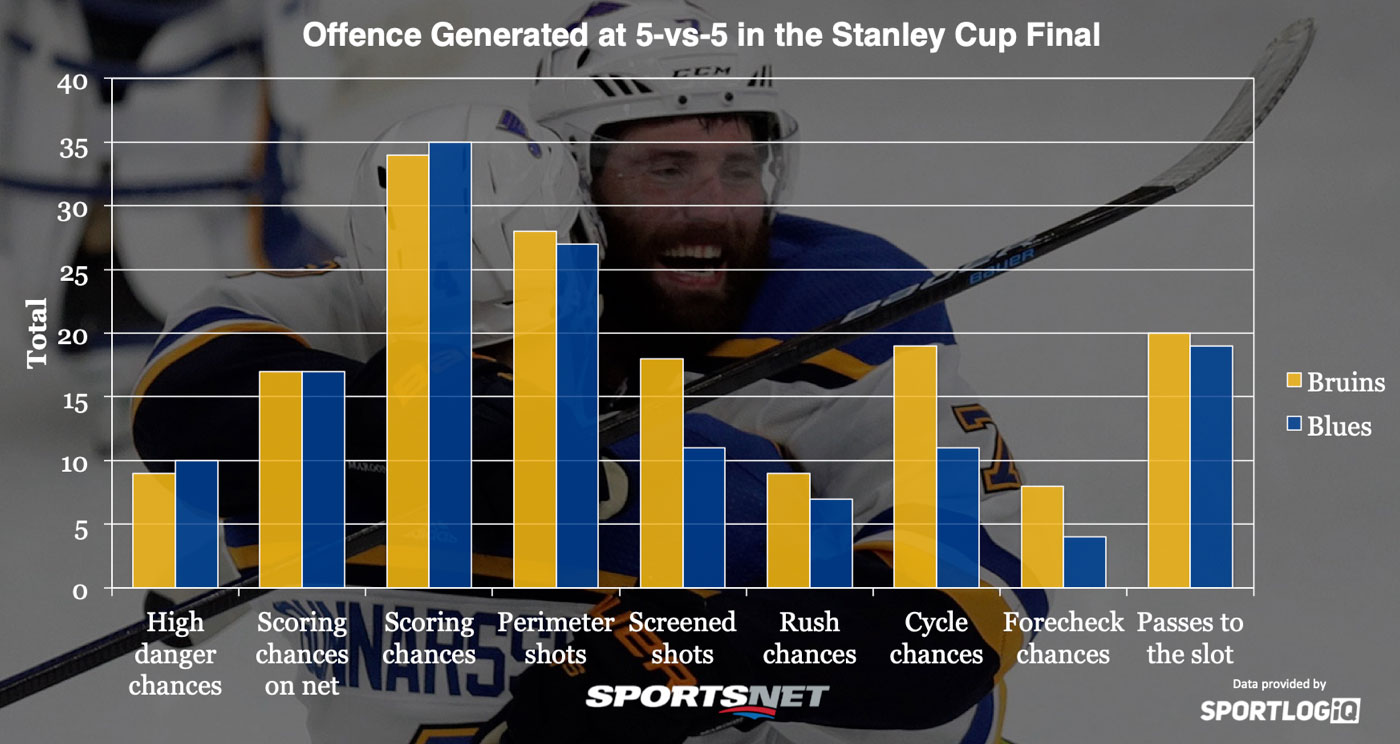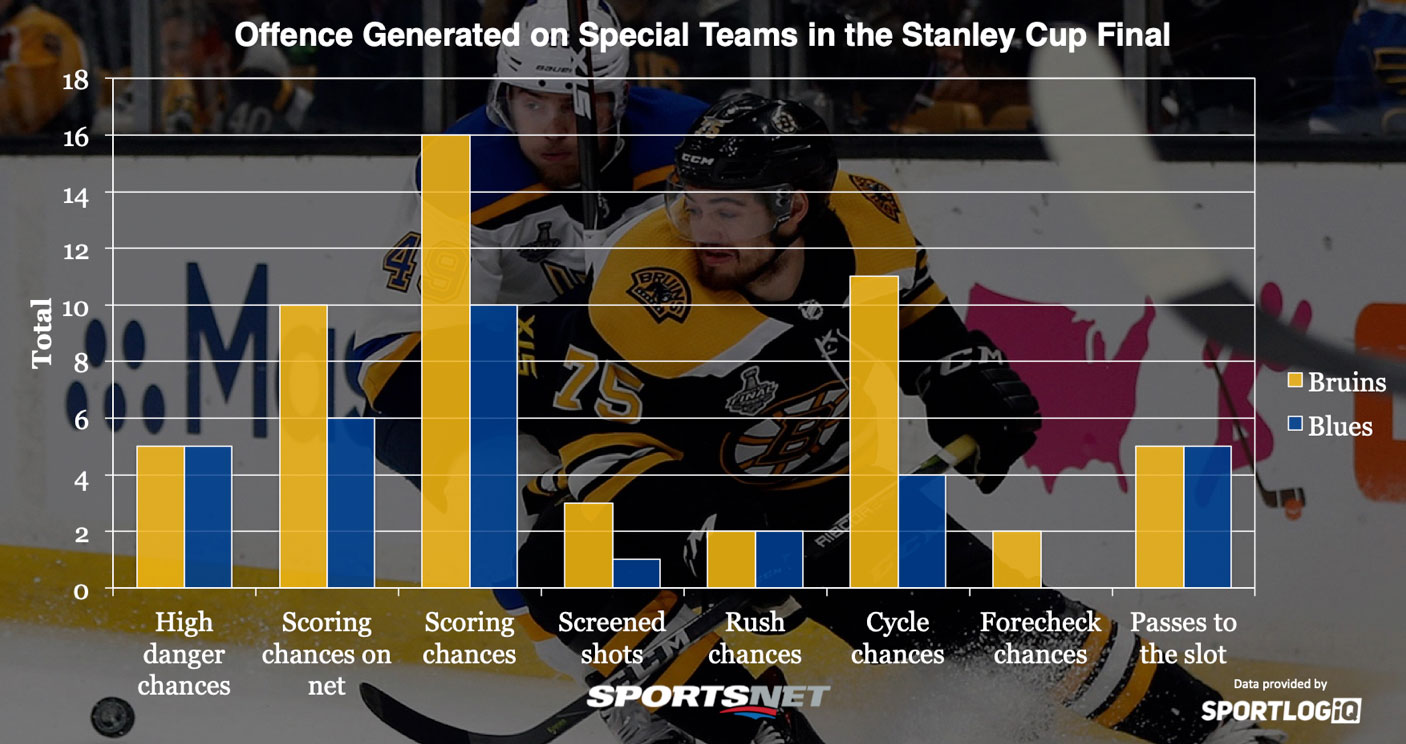The Boston Bruins and St. Louis Blues are headed to Missouri tied 1-1 in the Stanley Cup Final.
With all the time off the Bruins had after sweeping the Carolina Hurricanes, the opening most people saw for the Blues in this series was to surprise a rusty Bruins team in Game 1. But Boston showed absolutely zero signs of rust, out-chancing the Blues 26-9 in all situations to start the series.
With not many people picking the Blues to win the Cup in the first place, that they were dominated in Game 1 seemed a real kick in the gut for their chances. But in Game 2 they responded with an excellent performance, erasing two Bruins leads before taking the win in overtime on a ripper from Carl Gunnarsson.
With the Blues stealing home ice by earning the split, logically they’re in a better position to win now than they were heading in to the series. But how have things actually played out on the ice between these teams through two games? Let’s get into the details.

On the surface through two games at 5-on-5, things are remarkably even. A dominant Game 1 by the Bruins and a dominant Game 2 by the Blues have left us with almost identical numbers for the two teams in high danger chances, scoring chances on net, scoring chances overall, and perimeter shots.
That would lead us to believe that the two teams are on even ground, but when we get into more details and look at the extra factors that increase the likelihood of scoring, things look a little different.
So far, the Bruins have a strong advantage in getting screens on their shots on goal, 18 to the Blues’ 11, and they’re also getting more of their chances off the rush, more are preceded by cycle passes, and their forecheck has been much more successful at generating chances as well.
The Blues have been forced into attacking in straight lines more often than usual. They’ve gotten most of their scoring chances from static positioning, making it easier for Tuukka Rask to not only make saves, but control pucks to reduce second chances.
In the series so far the Blues have produced more offensive zonetime, and more shot attempts overall, but the Bruins are forcing more shots wide, blocking a higher percentage of them, and the same is true of passes.
St. Louis has attempted significantly more passes to the slot than Boston, 62 to the Bruins’ 43 at 5-on-5, but the Bruins have cut down the Blues’ slot pass success rate all the way to 30.6 per cent. Boston, meantime, is completing 46.5 per cent of its slot passes and have ended up connecting on slightly more overall.
This is a hallmark trait of the Bruins. They are masters of intercepting or interrupting passes through the middle in their own zone, and it often results in frustration for opponents, who either end up circling the perimeter constantly or take bad penalties.
Unfortunately for the Blues, the penalties seem to be a problem through two games. They’ve taken nine minor penalties at 5-on-5 through two games to Boston’s four, which brings us to special teams.

The Blues and Bruins have each taken another penalty outside of 5-on-5 hockey. So in viewing these numbers keep in mind that the Bruins have a 10-5 advantage in power play opportunities, which in real time has shaken out to 16:43 of power play time for the Bruins and 8:16 for the Blues.
With twice as much time on the power play, you’d expect the Bruins to have produced twice the quality chances if all things are equal, but that hasn’t been the case. The Bruins are absolutely dominating chances off the cycle, but the Blues have produced just as many high danger chances and completed just as many passes to the slot in half the time.
Those are good signs for the Blues, especially when you consider how absolutely lethal the Bruins’ power play has been this post-season. But it likely won’t convert into anything meaningful for them if they can’t get back to the disciplined hockey that got them here in the first place.
[snippet ID=3322139]
How the Bruins can take control
The Bruins are a great team, but how they flex on other great teams is almost always by pushing the envelope and managing to get away with it, while annoying their opponent so much that they retaliate and put themselves in trouble. Despite the numbers not being fantastic so far in the Stanley Cup Final, Boston’s power play is dangerous, so maintaining this 2:1 ratio in minor penalties against the Blues would be massive for the Bruins over a full series.
At 5-on-5, the Bruins could probably use a bit more offensive zone possession time in order to further exert control over the passing game, which is something they’ve done all playoffs long. But as things have played out so far in terms of shot quality, they’re in a strong position heading forward. Boston is still the favourite here.
How the Blues can take control
The Blues are going to have to stay disciplined. Boston can drive teams crazy, but they also usually take a fair amount of penalties themselves and St. Louis has looked pretty good on their infrequent power plays so far. That could be an area of exploitation as long as they’re not giving Boston twice the amount of chances they get.
The other main area that the Blues are going to have to work on is connecting on their slot passes. It’s one thing to simply not get the ensuing high quality look that comes with finding a teammate in the slot, but to have those passes intercepted as often as the Bruins have been able to through two games creates a defensive risk, and over time can make the Blues’ attackers more cautious. That all plays into the Bruins’ impeccable slot defence.
The most common ways to get the puck into the slot are either a defenceman from the point passing down for a forward to turn and shoot, or an East-West lateral pass that could be one-timed. The Bruins are exceedingly good at cutting down the East-West passes, and the ones from defencemen usually aren’t as dangerous.
One area the Blues have had some success with through two games has been going from low to high, either from behind the net or at the goal line to a forward in the slot. In order to maximize those plays, the Blues could get their more offensively inclined defencemen to start pinching into the high slot when the puck is down low to open up another passing lane to the slot for a one-timer, forcing the Bruins’ coverage to thin out a little.
That strategy carries more risk for odd-man rushes if the pass fails, either by being blocked, redirected, intercepted, or simply if the pinching defenceman bobbles it. But in order to solve the Bruins’ defensive scheme the Blues are going to have to take some more risks. This one, I think, is worth it.
[relatedlinks]







